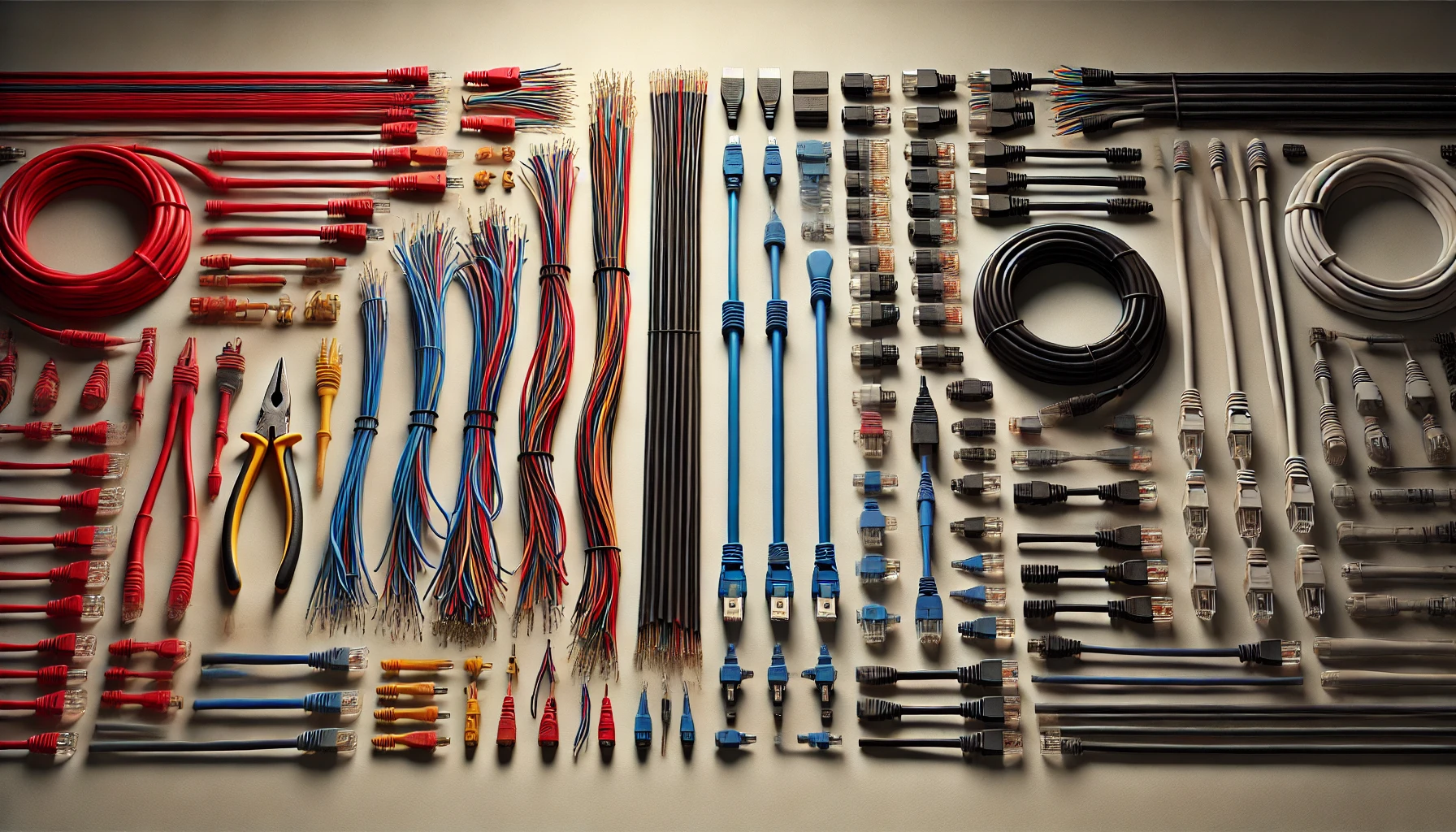
Introduction
Cables and wires are fundamental components in electrical and electronic systems, serving as the critical conduits through which electrical power, data, and signals are transmitted. Whether they power a simple household appliance or enable complex data communication in advanced technologies, understanding the basics of electrical cables and wires is essential for anyone involved in electrical work or electronics. This article offers a comprehensive overview of cables and wires, covering all the essential information to ensure your projects are successful and safe.
What are Cables and Wires? Understanding Their Basics and Key Differences
A wire is typically a single conductor, usually made of copper or aluminium, that carries electrical current. A solid wire comprises a single metal piece, while stranded wires are made up of multiple small wires twisted together. A cable is a group or bundle of wires encased in a single sheath, providing protection and reducing the risk of short circuits. Cables consist of a conductive material, a conductor that carries electric current, an insulator for preventing current leakage, a core–central conductor/group of conductors in a cable, and a sheath or jacket which serves as a protective layer of the cable. Together, cables and wires are ubiquitous in modern life, found in homes, businesses, industries, and telecommunications.
The Role of Cables and Wires in Modern Technology
The role of cables and wires in today’s technologies is undeniable, from powering smart homes to enabling high-speed data transmission. Additionally, they are the backbone of modern infrastructure, supporting everything from telecommunications to renewable energy systems. Their importance extends to emerging technologies such as smart home systems and electric vehicles, ensuring reliable operations, seamless integration, and system functionality.
Types and Functions of Cables and Wires Explained
Electrical cables and wires facilitate the flow of electricity, data, and signals. Based on multiple criteria, including their purpose, construction, and application, they can be classified into various types.
Types of Cables: A Brief Overview
Some common cable types include:
Cables Based on Purpose
- Power Cables: These cables transmit electrical energy from generation points to distribution points. Examples include XLPE/PVC power cables, armoured cables, and rubber cables.
- Control Cables: These are used to control electrical equipment and systems and include panel wire cables and LSHF safety cables.
- Communication Cables: Communication cables are designed to transmit data, voice, or video signals in various applications. Typical examples include Ethernet cables, coaxial cables, and fiber optic cables.
- Audio-Video Cables: AV cables are specifically designed to transmit audio and video signals in various applications. These cables come in multiple types, such as HDMI cables, VGA cables, and RCA cables.
Cable Types Based on Construction
- Single-Core Cables: They contain a single conductor.
- Multi-Core Cables: They comprise multiple conductors.
- Twisted Pair Cables: Twisted pair cables consist of two insulated conductors twisted together to reduce interference.
- Coaxial Cables: Coaxial or coax cables have a central conductor surrounded by an insulator, a shield, and an outer conductor.
- Fiber Optic Cables: They transmit data using light pulses through a glass or plastic core.
Cables Based on Application
- Household Cables: They are used for electrical installations in homes and buildings.
- Industrial Cables: They are ideal for use in industrial settings for power, control, and communication.
- Automotive Cables: These cables are found in vehicles for power, lighting, and electronic systems.
- Telecommunication Cables: They are employed for long-distance communication networks.
Types of Wires: A Brief Overview
Wires are essential components in countless applications, from electrical systems to telecommunications. Moreover, they come in various types, each with specific properties and uses:
Wires Based on Material
- Copper Wire: Copper wire, the most common wire, is widely favoured due to its excellent conductivity. It is used in electrical wiring, electronics, and telecommunications.
- Aluminum Wire: Aluminum wire is lighter than copper but less conductive. Due to its cost-effectiveness, it is often used in power transmission lines.
- Steel Wire: Steel wires feature high tensile strength and are used in construction, cables, and industrial applications.
- Gold Wire features excellent conductivity and resistance to corrosion. It is used in electronic components and jewellery.
- Silver Wire: Silver wire has high conductivity and is used in specialised electronic applications.
Wire Types Based on Insulation
- Bare Wire: Bare wire has no insulation and is thus used in direct grounding or specific industrial applications.
- Insulated Wire: As the name indicates, an insulated wire is coated with insulating material (rubber, plastic, etc.) to protect against electric shock and short circuits.
- Shielded Wire: It is a type of insulated wire with additional metallic shielding to protect against electromagnetic interference.
Wires Based on Purpose
- Power Wires: Conduct electricity for power supply (e.g., household wiring, power lines).
- Signal Wires: Transmit data or signals (e.g., audio cables, network cables).
- Ground Wires: Also called earth wires, they provide an electric current a path to flow safely to the earth.
- Heating Wires: Generate heat through electrical resistance (e.g., heating elements).
Cables vs. Wires: When and Which to Choose?
The decision between a wire and a cable depends on your specific needs, such as the purpose of the wire or the cable, the distance, the voltage and current needs, and environmental factors. When requiring a simple connection between two points, high flexibility, low voltage and current, and a cost-effective option, choose a wire. In contrast, choose a cable when you need power or data transmission over long distances, require high-speed data transfer with reduced EMI, and require high voltages and currents.
Final Words
Cables and wires are indispensable in the modern world, enabling the reliable and efficient flow of electricity and data that powers our lives. Understanding the different types, specifications, and applications of cables and wires is essential for anyone involved in electrical work, from professionals to DIY enthusiasts. Furthermore, the choice of a cable or wire entirely depends on users’ needs and preferences. Remember to pay attention to safety precautions when working with cables and wires.





















